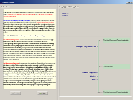Scale Types
Idiogrid employs a number of different scales. The user can select each
type of scale for the grid elicitation and manipulate a number of its
features. For instance, up to 9 categories can be defined for Likert-type
scales and their labels can be edited, a 'does not apply' option can be
toggled on or off for most scales, and the item stems can be edited.
Additional options are also available, and Idiogrid also included a novel
type of scale referred to as the Dynamic Analog Scale. Example of the
different types of scales follows:
Generally speaking, I am a
happy person:
Highly
Highly
Agree Agree
Uncertain Disagree
Disagree
5
4
3
2
1
Multi-point Rating Scale:
Please rate yourself on
the scale below:
Unhappy 1 2
3 4 5
6 7 Happy
Binary Rating Scale:
Generally speaking, I am:
Unhappy __ __ Happy
Ranking Scale
A process by which the elements are ordered
from greatest to least on each personal construct or dimension.
For example, a person may be asked to rank 'mom', 'dad', 'self', and
'brother' with regard to their overall happiness in life. The person may
rank 'mom' as happiest (rank = 1), 'brother' as second most happy (rank
= 2), 'Dad' as third most happy (rank = 3), and 'self' as the least
happy person of the group (rank = 4).
A new scaling procedure included in Idiogrid
in which the participant simultaneously rates various targets (usually people)
on a continuous scale anchored by adjective terms. The administrator
determines the anchors for the scales and can also provide extended
definitions of the scale anchors. The data that results from the rating
procedure will range in value from -200 to +200. A screenshot of this novel
scale can be seen here
 .
.
A short video describing how to use the DAS is
also posted here. One bit of
information the video omits, however, is that a target can be removed from the
rating scale by clicking the target with the right mouse button. Also, not all
targets must be rated on the scale for the user to proceed through and to
complete the procedures.
.